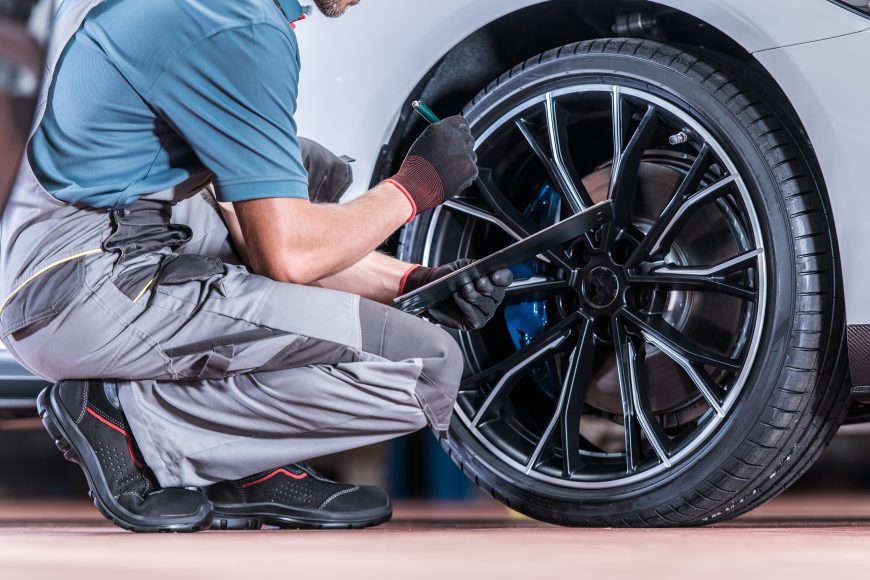- July 27, 2020
- By Murrays Tire Team
- In Tires
- 36971
- 0

Flat tires can happen anywhere and at any time. And emergency roadside assistance may not always be available. According to AAA, nearly 1 in 5 U.S. drivers don’t know how to change a flat tire.
It is essential to know how to properly and safely change a car tire. Here’s our step-by-step guide to changing a flat tire.
It’s not always easy to find a good spot for changing a tire safely. Aim for a level, hard surface with some distance between the road and your car. But don’t drive too long on your rim, or you’ll be paying for a new wheel as well.
Once you find a safe spot, park there. Then, turn off your engine and use the emergency or parking brake before you change a flat. And before you get out of your car, turn on your hazard lights.
After you’ve parked, you can place wheel chocks or a heavy rock behind the opposite side of the flat tire to keep your car from rolling.
Before you begin removing your flat tire, make sure all the tools are there. Check your spare tire as well, and make sure the tire is filled appropriately. Consult your owner’s manual to check where your jack, spare tire, and tire tools are.
We recommend trying out the tools and getting familiar with how to use them. With experience handling the tools, you’ll be more comfortable performing the next steps.
Waiting to learn to change a flat tire until an emergency happens can be frustrating and dangerous. We recommend practicing when your tire is not flat to get used to the steps.
If your car has a wheel cover, remove it first with a screwdriver or lug wrench. On some vehicles, the wheel cover is held in place by the lug nuts. Leave this style cover on the flat wheel.
Use the lug wrench to loosen the lugs nuts by turning the wrench counterclockwise. Hold the wrench and push down.
If the nuts are too tight, use penetrating oil to loosen them or push down on the lug wrench. You only want to loosen the lug nuts with one turn. Do not remove the lug nuts now.
Once your lug nuts are loosened, you can start to lift your vehicle using your jack. Turn the crank on the jack to raise it until it comes into contact with your car’s frame.
Make sure it’s touching a sturdy spot. Never place the jack under the vehicle’s axle or suspension.
When you lift your car, crank it up to at least 6 inches. It may need to be higher than 6 inches to remove the flat tire. Lower your vehicle to reposition the jack if you notice an instability.
Use the lug wrench to remove the lug nuts. Once you’ve removed them, place the lug nuts in a spot where you won’t lose them. A good place to place the lug nuts is the inside of your car door.
Once the lug nuts have been removed and stored safely, you can take the flat tire off with both hands. If it’s difficult to remove the tire, hit the rubber part of the tire with a hammer.
To remove it, pull the tire towards you. Once it’s off, place the flat tire under the car. It will act as a cushion in case your jack is unstable and drops your vehicle.
Put your spare tire in front of the wheel well. Once the tire is aligned with the wheel bolts, add your lug nuts. To put the lug nuts back on, turn them clockwise by hand.
Then take your wrench and turn the bolt tight enough to secure the tire before lowering it. Do not completely tighten them.
Slowly lower your vehicle back to the ground. Then remove the jack and block.
Once your car has been lowered, tighten the lug nuts as much as possible, in the proper sequence. There are different sequences for wheels with 4 and 5 lugs. Tightening the nuts in the appropriate order ensures that the wheel mounts correctly. It also ensures that the stress is evenly distributed over the wheel.
Take a deep breath; you did it!
Once you’re changed the tire, gather up all your tools and the flat tire and put them away. Before you start driving again, wipe your hands off to avoid smearing tar and dirt all over your interior.
Many spare tires are not full-size tires. These spares shouldn’t be driven at normal speeds and can only be driven for short distances. Check your owner’s manual for instructions and warnings for driving on a compact spare.
Most of the time, the tires are only rated for a max speed of 50-55 mph.
Driving faster on your spare could cause another blowout, which is something you’ll want to avoid. The car will also handle and brake differently, so be cautious and test the dynamics of the tiny tire.
Most spare tires are only designed to travel a small number of miles, so you’ll want to repair or replace your flat tire ASAP.
Drive to your nearest auto service and repair shop to have a professional technician evaluate your next steps. They’ll help you determine if you should repair or replace your damaged tire.
At Murray’s Tire & Auto, our experts are happy to help. Our team of skilled technicians is here to help you get back on the road safely and as soon as possible. Learn more about our tire and maintenance services today.





